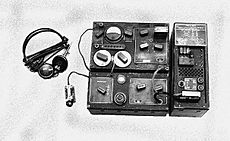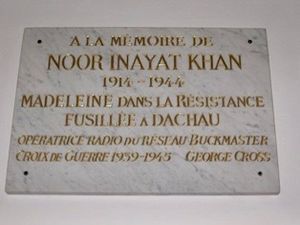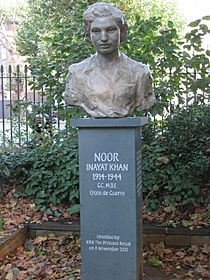Noor Inayat Khan facts for kids
Quick facts for kids
Noor Inayat Khan
|
|
|---|---|
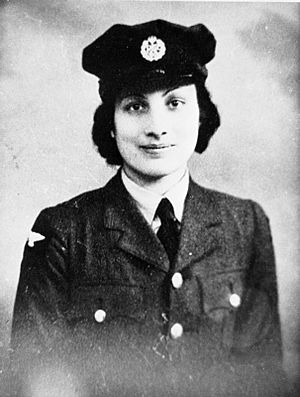
Noor-un-Nisa Inayat Khan, c. 1943
|
|
| Other name(s) | Nora Baker Madeleine (SOE codename) Nurse (SOE callsign) Jeanne-Marie Renier (SOE alias) |
| Born | 1 January 1914 Moscow, Russian Empire |
| Died | 13 September 1944 (aged 30) Dachau concentration camp, Bavaria, Nazi Germany |
| Allegiance | |
| Service/ |
Women's Auxiliary Air Force Special Operations Executive |
| Years of service | 1940–1944 |
| Rank | Assistant section officer |
| Unit | Cinema (SOE) |
| Battles/wars | Second World War |
| Awards | Mentioned in dispatches |
Noor-un-Nisa Inayat Khan (born January 1, 1914 – died September 13, 1944) was a brave British secret agent during World War II. She worked for the Special Operations Executive (SOE). The SOE was a special group that carried out secret missions. These missions included spying, sabotage (damaging enemy property), and gathering information. They worked in countries taken over by the Axis powers, especially Nazi Germany.
Noor Inayat Khan was known by her secret codename, Madeleine. She became the first female wireless operator sent from the UK into occupied France. Her job was to help the French Resistance during World War II. Sadly, Noor was betrayed and captured. She was later executed at the Dachau concentration camp. After the war, she received the George Cross. This is the highest award for bravery given to civilians in the United Kingdom.
Contents
Early Life and Family
Noor Inayat Khan was born in Moscow, Russia, on January 1, 1914. She was the oldest of four children. Her siblings were Vilayat, Hidayat, and Khair-un-Nisa.
Her father, Inayat Khan, was from India. He came from a family of musicians and nobles. He taught Sufism, a peaceful spiritual path. Her mother, Pirani Ameena Begum, was an American woman. She met Noor's father in the United States.
In 1914, just before World War I began, Noor's family moved to London. They later moved to Suresnes, near Paris, France, in 1920. As a child, Noor was quiet and thoughtful. When her father died in 1927, 13-year-old Noor helped care for her mother and younger siblings.
She studied child psychology at the Sorbonne. She also studied music at the Paris Conservatory. She composed music for the harp and piano.
Becoming a Writer
As a young woman, Noor started a career as a writer. She wrote poetry and children's stories. Her work was published in English and French magazines. She also wrote for French radio.
In 1939, her book Twenty Jataka Tales was published. This book was inspired by ancient Buddhist stories.
When World War II began, German troops invaded France. Noor's family fled to England in June 1940. They landed in Falmouth, Cornwall.
Joining the War Effort
Noor believed in peace, but she and her brother Vilayat wanted to fight against the Nazis. She felt it was important for Indians to show bravery in the war. She hoped it would help connect the British and Indian people.
In November 1940, Noor joined the Women's Auxiliary Air Force (WAAF). She trained to be a wireless operator. This meant she would send and receive secret radio messages.
Becoming a Secret Agent

Noor was later chosen to join the Special Operations Executive (SOE). This was a very secret organization. In early 1943, she began special training as a wireless operator. Her training took place in places like Wanborough Manor and Aylesbury.
Noor was the first woman to be sent into occupied France as a wireless operator. Other women agents before her were mostly couriers (messengers). She was good at sending messages quickly and accurately.
Part of her training included a mock Gestapo interrogation. This was to prepare agents for what might happen if they were captured. Noor found this very difficult and was quite scared. Some of her instructors worried she was too sensitive for secret work. However, her superiors, like Maurice Buckmaster, believed in her determination.
Noor was small and not very athletic. But she was a natural at sending Morse code messages. Her musical talent helped her with this. Vera Atkins, an intelligence officer, was sure of Noor's commitment. Noor wanted to do something active and brave for the war.
Noor's mission was very dangerous. Wireless operators had one of the riskiest jobs. They kept London connected to the French Resistance. They sent messages about sabotage plans and where to send weapons.
Operators had to hide their radios and antennas. They would tap out Morse code messages. If they stayed on the air for more than 20 minutes, the enemy could find them. In 1943, a wireless operator's life expectancy was only about six weeks.
Before her mission, Noor was very worried. Her brother, Vilayat, also tried to stop her. He reminded her of their family's belief in non-violence. But Noor felt she had to help.
Vera Atkins met with Noor to make sure she was ready. Atkins told her she could back out without any problems. But Noor insisted she wanted to go. Her only concern was her family. She asked Atkins to protect her mother from bad news if she went missing. Atkins agreed.
Noor was promoted to Assistant Section Officer. She flew to France on a Westland Lysander plane in June 1943. These planes could land in small, rough fields. She was given a new identity as a children's nurse, "Jeanne-Marie Renier." Her SOE codename was "Madeleine."
Noor's ability to speak fluent French and her skill with the radio made her very valuable. On June 16/17, 1943, she landed in Northern France. She was with two other agents, Diana Rowden and Cecily Lefort.
Capture and Imprisonment
Soon after Noor arrived, the secret network she was part of began to be captured by the Germans. Noor stayed in contact with London. Her boss, Buckmaster, offered to fly her home. But Noor chose to stay. She believed she was the only radio operator left in Paris.
Noor Inayat Khan was betrayed to the Germans. It is believed that Renée Garry, the sister of another agent, was responsible. She may have been paid for her actions.
Around October 13, 1943, Noor was arrested. She was questioned at the SD Headquarters in Paris. She tried to escape twice. The head of the SD in Paris, Hans Kieffer, later said that Noor never gave them any real information. She lied consistently.
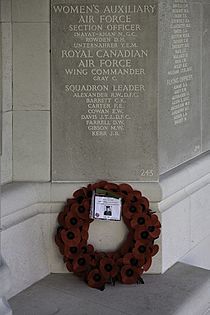
However, Noor had made a mistake. She had copied all the messages she sent into her notebooks. This was against security rules. Even though she didn't reveal her secret codes, the Germans used her notebooks. They were able to send fake messages pretending to be her.
Some people believe London should have noticed that the messages were fake. The way an operator taps Morse code, called their "fist," is unique. Noor had a very distinct "fist." However, the German secret service was very good at faking these. Another agent, Déricourt, also gave SOE secrets to the Germans. This led to more agents being captured and killed.
On November 25, 1943, Noor escaped from the SD Headquarters with two other prisoners. But they were quickly recaptured. After refusing to promise not to escape again, Noor was sent to Germany. She was held in secret at Pforzheim prison. For ten months, she was kept alone, with her hands and feet shackled.
Noor was considered "highly dangerous." She remained uncooperative and refused to give any information. Other prisoners could hear her crying at night. But she managed to scratch messages on her mess cup. She told another inmate her name, Nora Baker, and her mother's address in London.
Execution
Noor Inayat Khan was suddenly moved to the Dachau concentration camp. Three other agents, Yolande Beekman, Madeleine Damerment, and Eliane Plewman, were with her. At dawn on September 13, 1944, all four women were executed.
A Gestapo officer named Christian Ott later spoke about what happened. He said that another officer, Max Wassmer, told him that Noor was beaten before she was shot. Her last word was reported to be "Liberté" (French for "Freedom"). Noor's mother and three siblings survived her.
Honours and Awards

Noor Inayat Khan was given the George Cross in 1949, after her death. This is Britain's highest award for bravery for civilians. She also received the French Croix de Guerre 1939–1945 with a silver star.
She was the third woman from the First Aid Nursing Yeomanry (FANY) to receive the George Cross during World War II.
In 2011, a campaign started to raise money for a bronze statue of her in London. The statue was unveiled on November 8, 2012, in Gordon Square Gardens. This is near where she used to live.
In 2014, Noor was featured on a stamp by the Royal Mail. In 2018, there was a campaign to have her image on the new Bank of England £50 note.
Blue Plaque
On February 25, 2019, it was announced that Noor Inayat Khan would receive a blue plaque. This plaque is a special marker on buildings in London. It was placed at her wartime home at 4 Taviton Street in Bloomsbury. This was the house she left for her final mission. It was also the address she scratched onto her mess cup in prison.
Noor is the first woman of South Asian descent to have a blue plaque in London. The plaque was unveiled in a special online ceremony on August 28, 2020.
See also
 In Spanish: Noor Inayat Khan para niños
In Spanish: Noor Inayat Khan para niños
- British military history of World War II
- Military history of France during World War II
- Resistance during World War II


